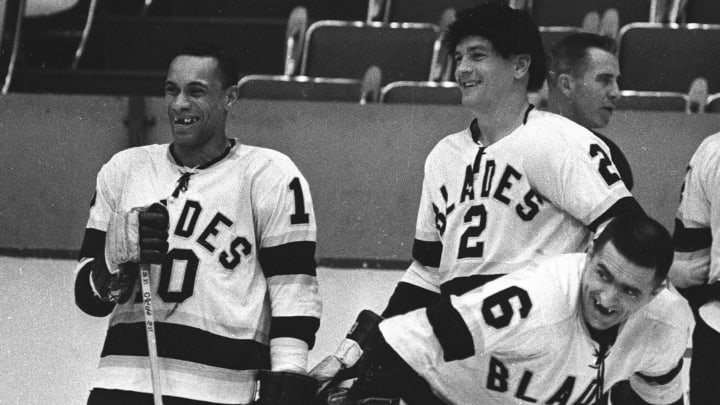
The Barrier
It’s 1949, I’m 14 years old, and my hometown team has just won the Junior Championships.
In baseball, that is.
The reward for winning is a fairly good one: our whole team gets a trip to New York City. We’re going to visit Radio City Music Hall. We’re going to climb to the top of the Empire State Building. We’re going to walk along Coney Island.
Oh, and one more thing.
We’re going to meet Jackie Robinson.
It’s happening on our last day, after a Dodgers game in Brooklyn. Jackie has just broken baseball’s color barrier — only two years prior, in 1947 — and already, to us, he’s nothing short of an icon. So we watch the Dodgers game — one teammate more excited than the next. It ends, as games do. It’s finally time.
It’s time to meet Jackie.
They run and get him. The team forms a line as we each wait our turn. One by one, I watch my teammates shake the hand of The Great Jackie Robinson. Sometimes it’s a handshake and a smile. Sometimes it’s a quick word. At long last, Jackie gets to me.
“Nice to meet you, Mr. Robinson,” I say. “I’m Willie O’Ree.”
“Nice to meet you, Willie,” Jackie says, shaking my hand.
He flashes a smile, and I can sense him moving on — shifting his posture to the next kid on the team. I turn to him, slightly.
“I’m a baseball player,” I say, raising my voice. “But what I really love — is hockey.”
“Oh?” Jackie says, turning back to me, still smiling. “I didn’t know Black kids played hockey.”
I smile back.
“Yup.”
I didn’t even know.
It’s the darndest thing — but I didn’t even know.
On January 18, 1958, when I stepped onto the ice to play for the Boston Bruins, I honestly had no earthly idea that I was breaking hockey’s color barrier.
Before I got the call from the Bruins, I had been playing in Quebec with the Quebec Aces. For two straight seasons, in ‘56 and ‘57, I’d been invited to Bruins training camp. I’d hoped that they would keep me on — but nothing ever came of it. And so each year, once camp wrapped, I headed back to Quebec.
Finally, in January of ‘58, I got the call. The Bruins had contacted the Aces. We want O’Ree. I was to meet the team in Montreal and play a full pair of games — a home-and-home against the Canadiens.
I couldn’t have been more thrilled. I called my mom, dad, brother and sister to share the news. I was going to be playing for the Bruins, in Montreal, against the Canadiens — that very next day. Wow: I, Willie O’Ree, was going to be an NHL player.
My family gladly made the trip. It was about a 500-mile drive from our hometown of Fredericton, New Brunswick, but they wanted to be there to witness history. As in, my history. See: I didn’t know about the color barrier — but, as it turns out, my family didn’t know either. I was just there to play hockey. And they were just there to be proud of me. Like I said — the darndest thing.
Before the game, the Bruins’ coach, Milt Schmidt, and general manager, Lynn Patrick, took me aside and sat me down. They said, “Willie, we brought you in because we knew that you could add a little something to the team. Don’t worry about anything that happens on the ice. The Bruins organization is behind you 100 percent.” In the locker room, the Bruins players were incredibly supportive toward me. I was treated like any other player, and with the utmost respect. It meant the world to me.
I stepped onto the ice and I had butterflies in my stomach. The Canadiens were the best team in the league at that time. They were winning Cup after Cup. Maurice “Rocket” Richard, Jacques Plante, Bernie Geoffrion, Doug Harvey … these were superstars of the highest order. The Rocket, in particular, was one of my idols growing up. To share the ice with these guys, and play against them in an NHL game, was surreal.
Even more surreal: We won, 3-0. Now, I wasn’t just an NHL player. I was a winner, too.
But like I said — that’s what I was focused on: the hockey. I had no idea at all, during the game itself, about breaking the color barrier. In fact, it wasn’t until the next morning that I found out — while opening up the newspaper at breakfast.
I was looking for my name in the box score.
Instead I found it in the headline.
Every now and then, when I’m reminiscing about my career, someone will ask me about the racist remarks that people would make to me “back then.” And when they do, my first thought is always the same: What do you mean, “back then”?
If by “back then” they mean “a few weeks ago,” then I have just the story for them.
I was on the road for work and had just checked into my hotel. I was getting off the elevator — and as the doors slid open, I made eye contact with a man. We didn’t know each other; had never met. But he saw me. Saw the color of my skin. And for him, I guess, that was enough. He made a racial slur at me, with impunity, right to my face. Then he walked onto the elevator … and the doors closed … and he went on with his day.
The sad truth of the matter is that racism remains with us — now, today, at this very moment. And that goes for every kind of racism, even the kind that many imagine to be a relic of the ‘50s. So, as far as stories go: Did fans throw black cats on the ice when I played? Sure. Did they throw cotton balls at me? You bet. But you don’t need my old stories. You’d only have to travel back four years to hear about the banana peels thrown at Wayne Simmonds of the Flyers.
That’s 2011, if you’re counting — not even last decade. Is that disappointing to me? Of course it is. But those people are simply out there, still. It’s our harsh reality.
To this day, when I’m confronted with that reality, I think back to my older brother, Richard.
Richard was not only my brother and my friend — he was my mentor. And he taught me a lot about what I needed to do if I wanted to pursue a career in hockey. I can still remember us back in Fredericton, as teenagers, on one of our final fishing trips before I left home for Juniors. We were talking about what to expect once I got out there. And Richard looked at me, and he said, “Willie, names won’t hurt you unless you allow them to hurt you. And if there are people out there who won’t accept you for who you are — then forget them.” Those might sound like simple concepts, but they were anything but. To me … they were everything.
And, in fact, they still are.
What Richard did that was so special was he allowed me to take these racist slurs — slurs that otherwise might have dispirited me as a young player, haunted me and shamed me out of pursuing my dream — and flip them into an important lesson about my personhood. Richard taught me to understand that the ignorance built into those slurs was, among other things, ignorance to my value as an individual. And he ingrained in me a principle that I would carry with me up through this very day: that hockey is for everyone — and that “standing out” is a beautiful thing.
He gave me permission to live my life.
And I did.
And now I’m working to make sure that other kids live theirs.
We’re making a lot of progress.
When I started working with the NHL in 1998, as the Director of Youth Development for the league’s diversity task force, we only had five diversity programs throughout North America. Now we have over 45. And these programs are doing so many wonderful things, at the highest levels: We’re building rinks. We’re running clinics. They are becoming a huge part of the solution to some truly complex problems.
But there is another level on which what we’re doing is extremely simple — really, when you get down to it, as simple as it gets: the level of exposure. We’re exposing more people than ever before to one of the most beautiful and generous sports in the world. And we are instilling in kids, who may have previously felt alienated from hockey, what my brother instilled in me all of those years ago: that hockey is for them, too.
In my first year as Director, we were in Chicago for All Star Weekend — working with the city’s local diversity program, P.U.C.K. (“Positive Uplifting of Chicago Kids”). While I was there, I met this young Black boy named Gerald — 13 years old, a real skinny kid. And he just walked up to me, point blank, and said, “Mr. O’Ree, I want to be a goalie. And I want to play in the NHL.”
Gerald’s parents weren’t keen on the idea. They saw his potential as an athlete — but thought he’d be held back in hockey, and get fewer opportunities because of his skin color. His friends tried to get him to quit hockey for basketball — he was a really good basketball player, and hey, he’d get to hang out with his friends. But Gerald stuck to his guns. He said, “No, I’m going to be a goalie, and I’m going to play in the NHL.” No matter how often people tried to convince him that he was wasting his time because of the color of his skin, he stuck with it.
Five years later, in 2003, Gerald was drafted by the Tampa Bay Lightning. On November 11, 2005, he made his NHL debut.
Gerald is Gerald Coleman, and he went on to have a 10-year career playing professional hockey. He was never the biggest name. And he was never the biggest star. But he made it. And he made it because he was given a reason to have faith — faith in the simple idea that hockey was “for” a skinny, 13-year-old Black kid from Chicago. That hockey was for him.
That hockey is for everyone.
It’s 1962, I’m 27 years old, and I’ve just been invited to an NAACP luncheon.
I’m there with the coach of my current team, the Los Angeles Blades, and a few other players. My coach notices the guest of honor, standing over in the corner — minding his business, talking to some people. He waits a few minutes for their conversation to end. And then he brings me over.
He taps the guest of honor on the shoulder.
“Mr. Robinson, I’d like you to meet one of our players, Willie O’Ree.”
Jackie Robinson turns around, and looks at me for a moment.
“Willie O’Ree,” he says, shaking my hand. “You’re the young fellow I met in Brooklyn.”
I’m 80 years old now, and it’s hard to believe where the time has gone.
All of these years later — people still, to this day, will come up to me and say, “I didn’t know Black kids played hockey.” And when they do, I’ll crack that same smile I cracked to Jackie back in 1949.
And then I’ll turn to them slightly, raise my voice just a little, and say the only word that anyone discovering this game should ever have to know:
“Yup.”

